Today, a one-page review of ASUS ROG Strix GeForce GTX 1080 OC 8GB gaming graphics card.
Article index:
- 1 – Overview
- 2 – Gallery
- 3 – GPU Data
- 4 – Benchmarks
- 5 – GPU Bun-in Test
- 6 – ASUS GPU Tweak and AURA RGB Lighting
- 7 – Conclusion
- 8 – Other Reviews
1 – Overview
This GeForce GTX 1080 is the flagship member of the ROG Strix family.
The reference GTX 1080 comes with a GPU clocked at 1607MHz (base clock) and 1733MHz (boost clock). These clock speeds are too low for ASUS who has overclocked the GPU at 1784MHz (base clock) and 1936MHz (boost clock). The Strix GTX 1080 comes with a factory overclocking of +11% (or +203MHz). This out-the-box overcloking involves more power consumption. That’s why the Strix GTX 1080 requires 8-pin + 6-pin additional power connectors (there is only one 8-pin connector on NVIDIA reference board).
The 8GB of GDDR5X graphics memory are overclocked with a small +10MHz: 10010MHz (effective speed) against 10000MHz for the reference board.
One the geeky features that most of the GTX 1080 have in common is the RGB lighting on the VGA cooler. In this field, the Strix GTX 1080 comes with the Aura RGB Lighting to control the lighting effects of the card.
The homepage of ASUS Strix GTX 1080 can be found HERE.
2 – Gallery
All photos have been taken with a Samsung Galaxy A5 2016 mobile phone.
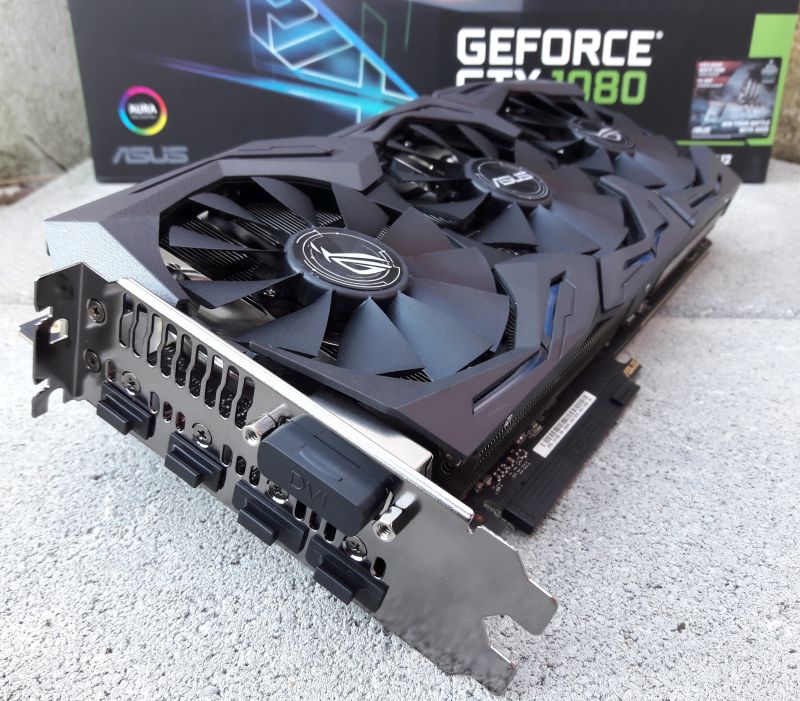
The Strix GTX 1080 is equipped with the DirectCU III VGA cooler which features triple 0-dB fans. When the GPU temperature is below a threshold, the fans are stopped resulting a fully quiet graphics card.
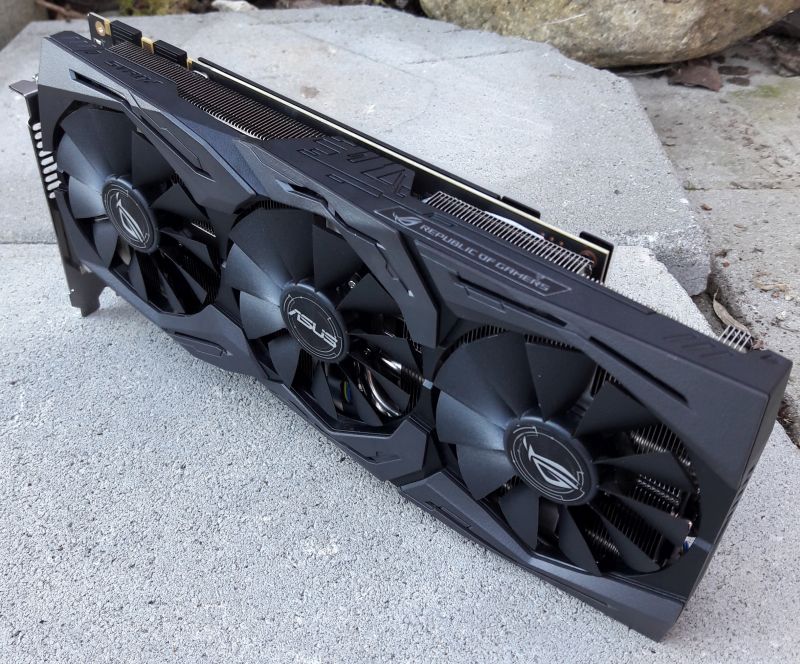
The card includes two connectors for driving PC case fans. The case fans are synchronized with VGA cooler fans.
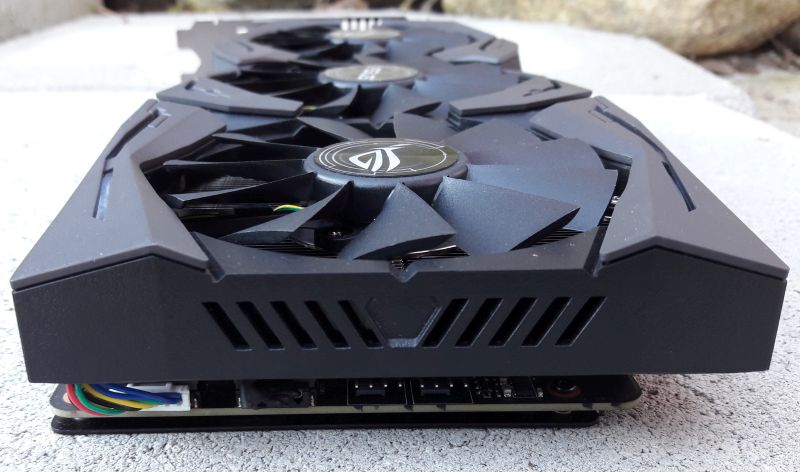
The card features two HDMI 2.0 connectors (for 4K resolutions at 60Hz on UHD TVs), two DisplayPort 1.2 connectors (they are DP 1.3/1.4 ready too):
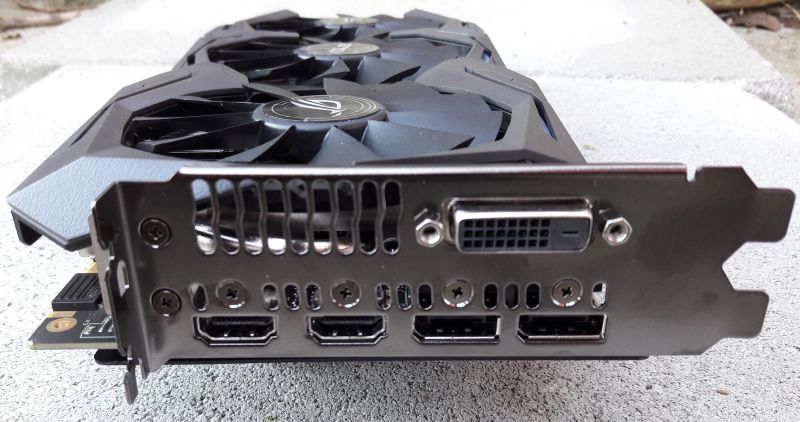
Like all GTX 1080, the Strix model has a nice backplate:
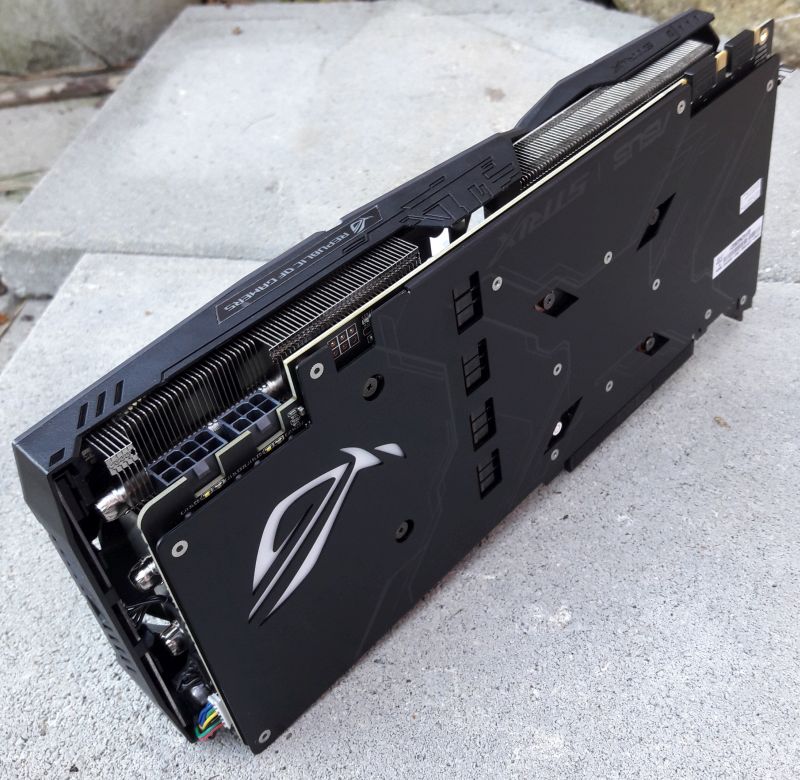
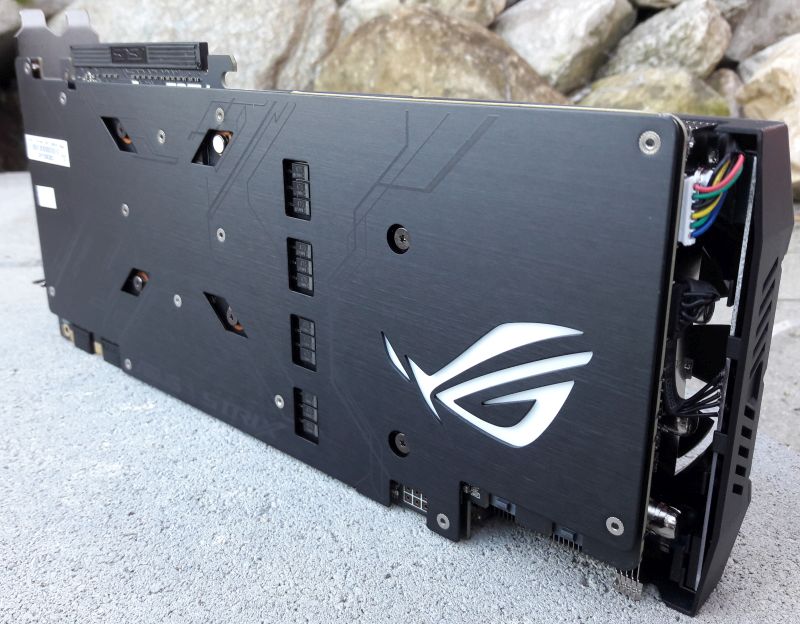
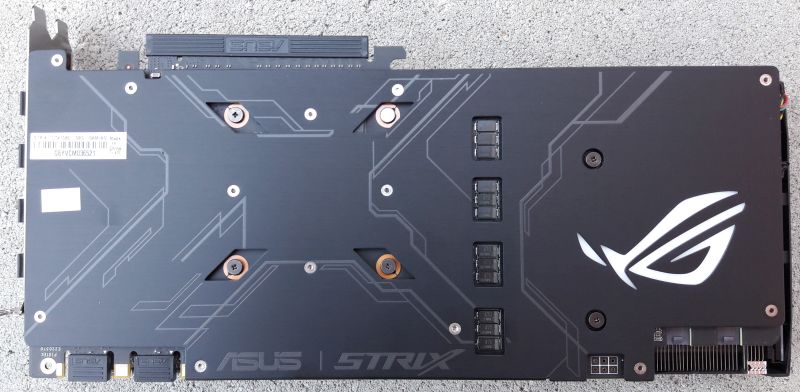
With its factory overclocking, the Strix GTX 1080 requires more electrical power: 8-pin + 6-pin power connectors allowing the board to consume up to 300W:
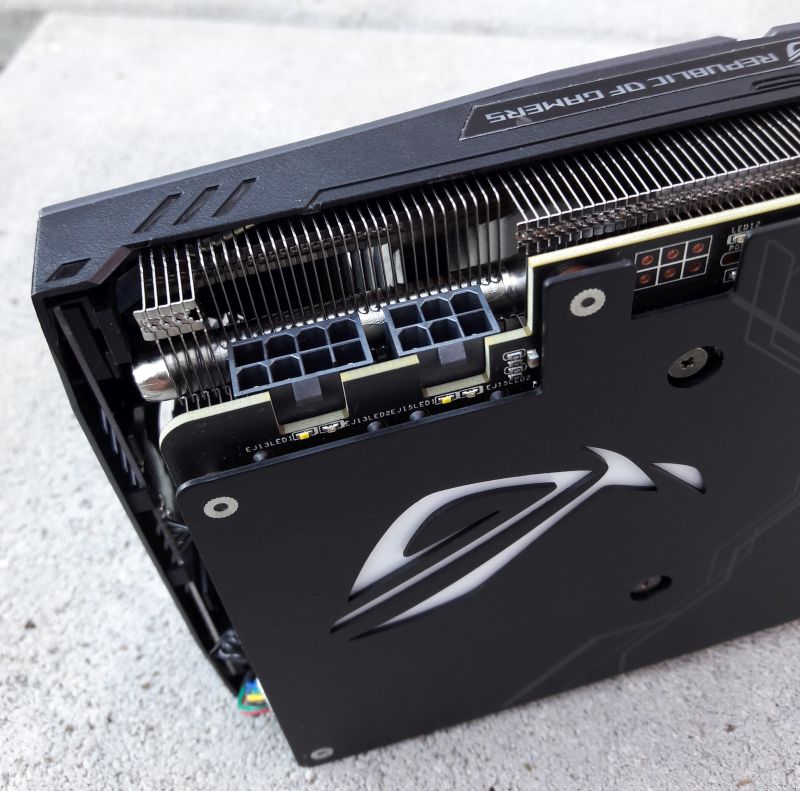
The board includes two LEDs to the power connectors to indicate if power supply is good or not:
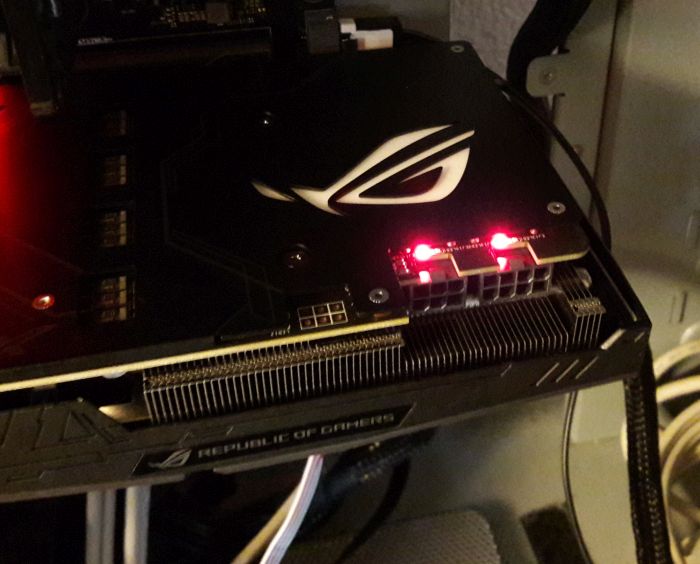
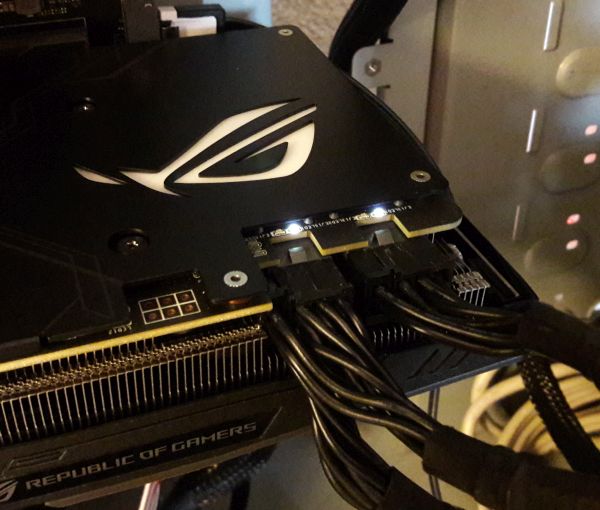
The card support 2-way, 3-way and 4-way SLI. But 3-way and 4-way SLI are disabled. The user has to request an Enthusiast Key for SLI setups with 3 or 4 GPUs.
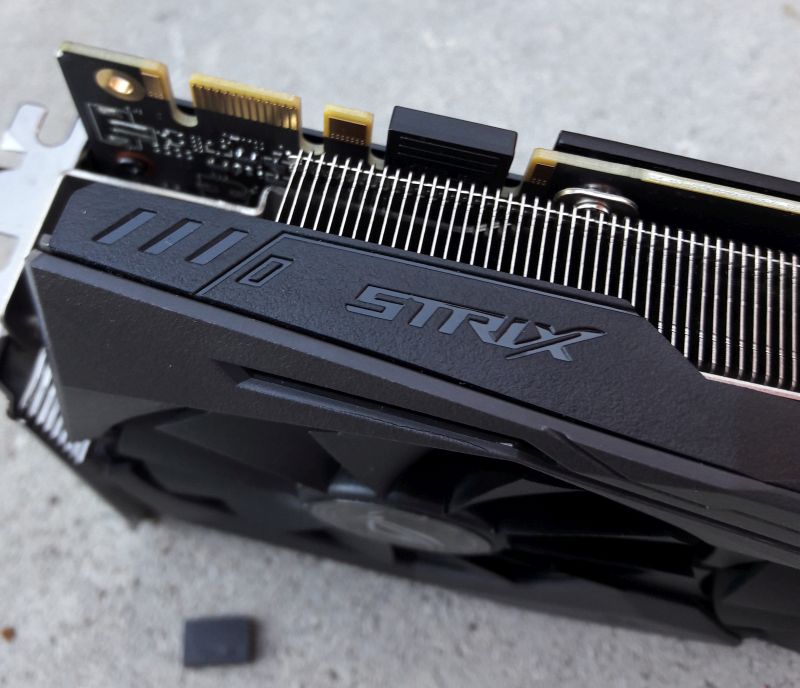
The bundle is minimal: the graphics card, a CDROM with GPU Tweak and graphics drivers, a power connector cable, two ROG velcro hooks and an invitation code for the World of Warships game:
Box details:
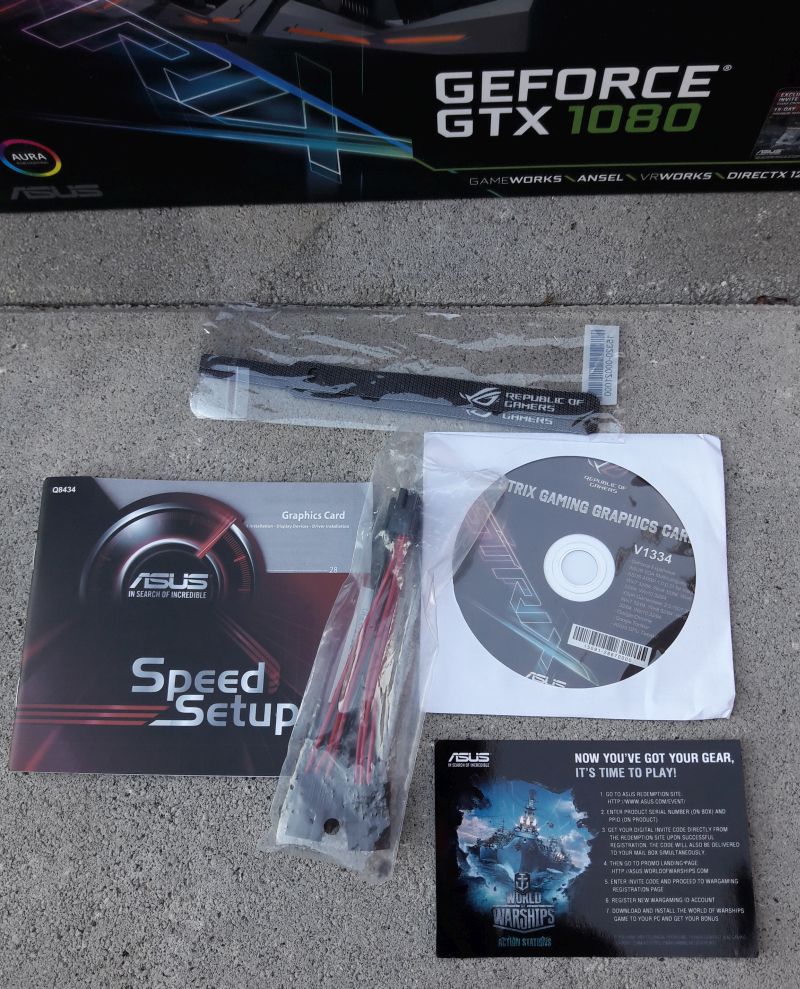
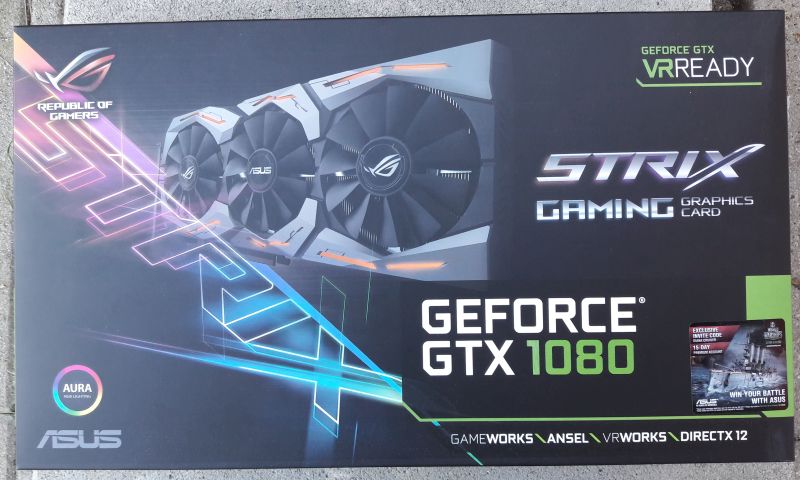
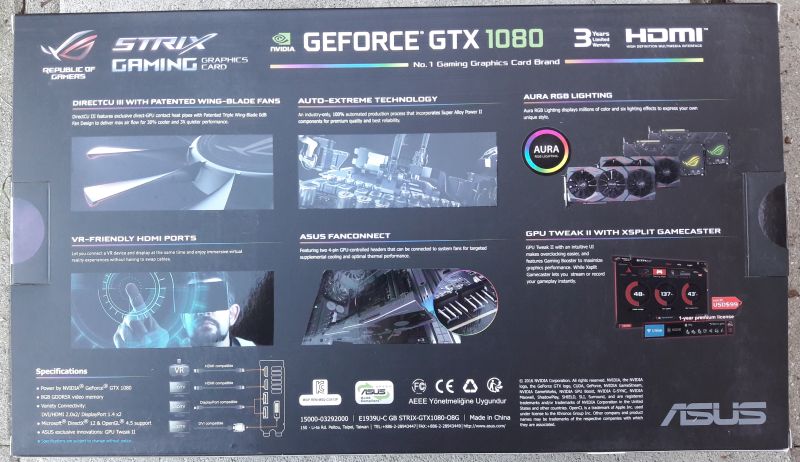
The Strix GTX 1080 compared to the reference GTX 780:
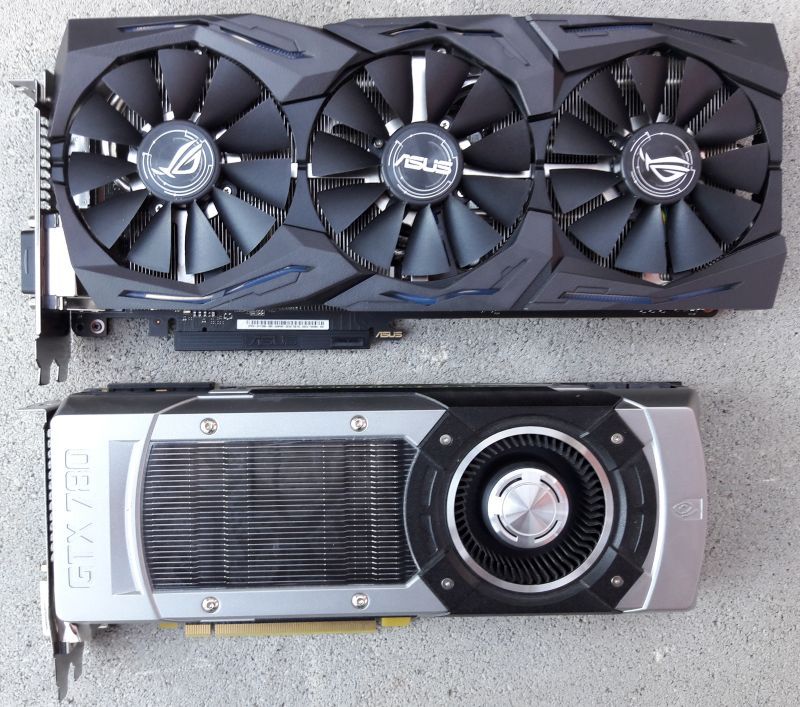
3 – GPU Data
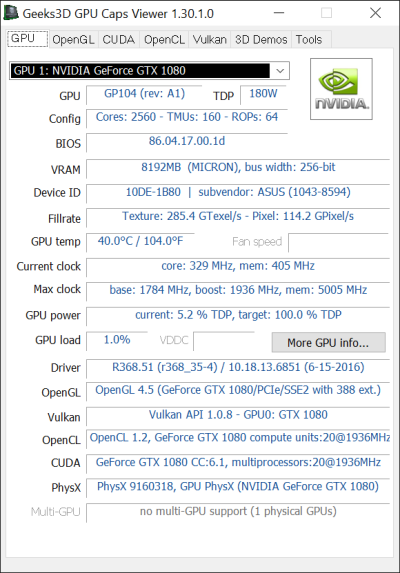
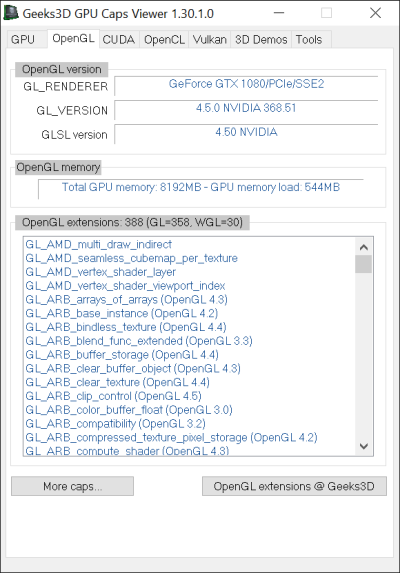
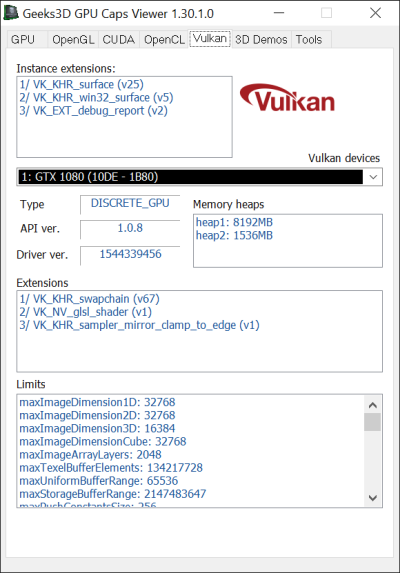
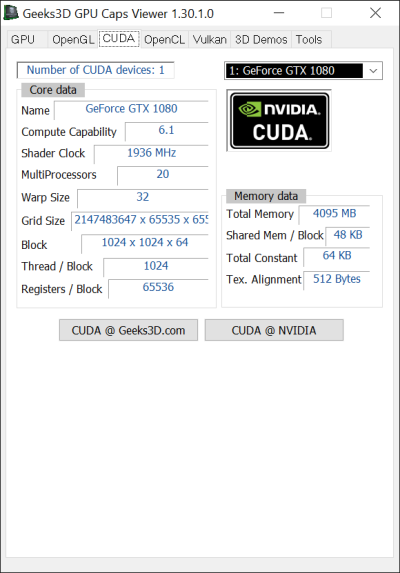
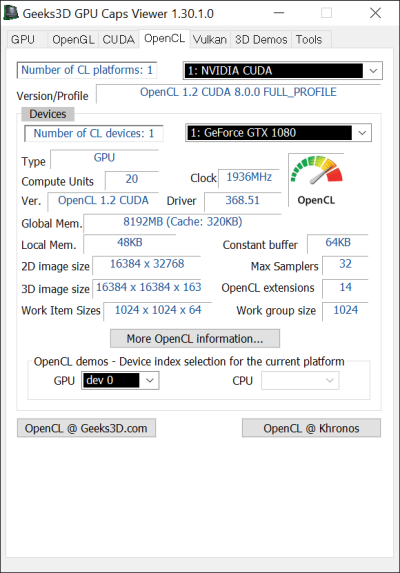
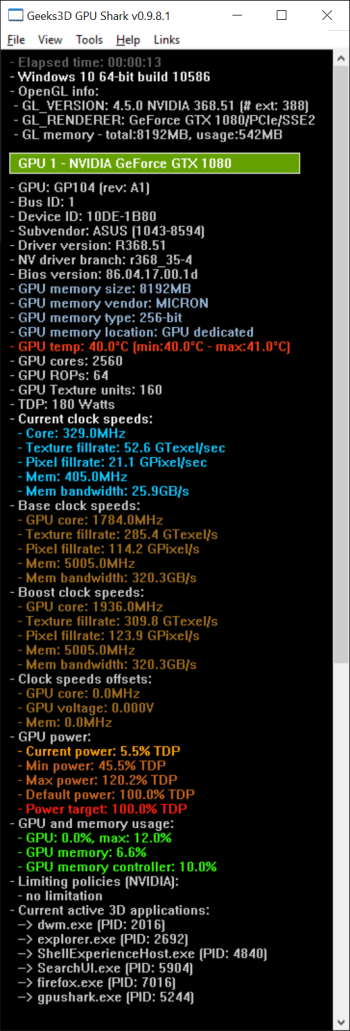
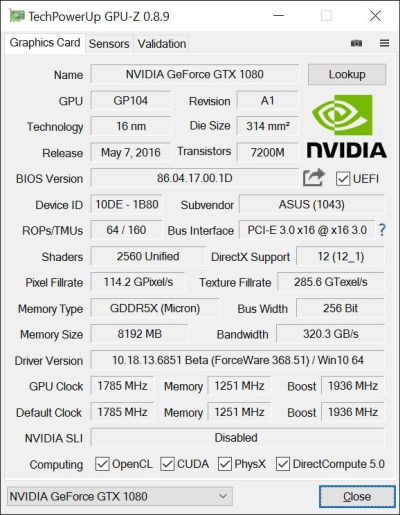
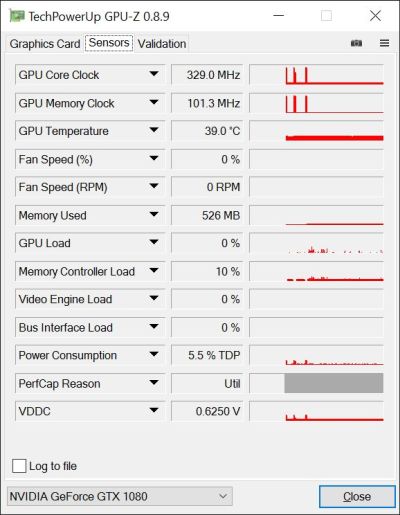
4 – GPU Benchmarks
4.1 – 3DMark Sky Diver
| 29024 – ASUS GeForce GTX 1080 Strix – R368.51 |
| 25134 – ASUS GeForce GTX 980 Ti – R353.06 |
| 23038 – ASUS GeForce GTX 980 Strix – R344.75 |
| 21964 – MSI Radeon R9 290X Gaming – Catalyst 14.9 WHQL |
| 21811 – Gainward GeForce GTX 970 Phantom – R344.75 |
| 20274 – EVGA GeForce GTX 780 – R344.75 |
| 17570 – MSI Radeon HD 7970 – Catalyst 14.9 WHQL |
| 17533 – EVGA GeForce GTX 680 – R344.75 |
4.2 – 3DMark Fire Strike
Fire Strike is a Direct3D 11 benchmark for high-performance gaming PCs with serious graphics cards.

| 15583 – ASUS GeForce GTX 1080 Strix – R368.51 |
| 12514 – ASUS GeForce GTX 980 Ti – R353.06 |
| 10574 – ASUS GeForce GTX 980 Strix – R344.75 |
| 9382 – MSI Radeon R9 290X Gaming – Catalyst 14.9 WHQL |
| 8870 – MSI GTX 970 CLASSIC 4GD5T OC – R344.75 |
| 8203 – EVGA GeForce GTX 780 – R344.75 |
| 6572 – MSI Radeon HD 7970 – Catalyst 14.9 WHQL |
| 6399 – ASUS Strix GTX 960 DC2 OC 4GB – R353.06 |
| 6235 – EVGA GeForce GTX 680 – R344.75 |
4.3 – 3DMark Fire Strike Ultra
| 5125 (Graphics score: 5330) – ASUS GeForce GTX 1080 Strix – R368.51 |
| 2617 (Graphics score: 2592) – MSI GTX 970 CLASSIC 4GD5T OC – R368.69 |
| 2178 (Graphics score: 2134) – EVGA GeForce GTX 780 – R368.69 |
4.4 – FurMark 1.17
FurMark is an OpenGL 2 benchmark that renders a furry donut. This benchmark is known for its extreme GPU workload.
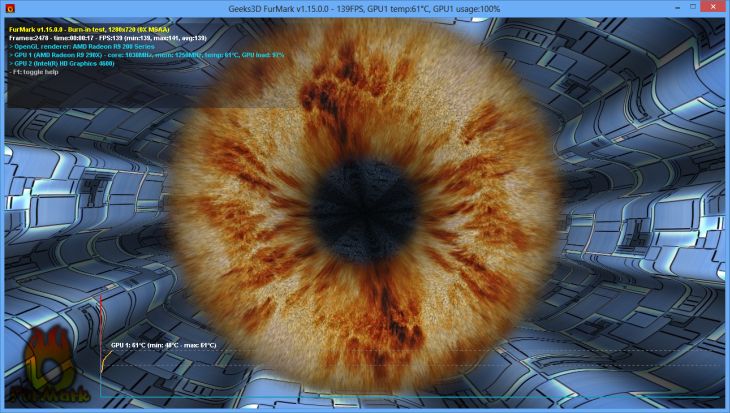
Settings: Preset:1080 (1920×1080)
| 7151 points (119 FPS) – ASUS GeForce GTX 1080 Strix – R368.51 |
| 6233 points (103 FPS) – ASUS GeForce GTX 980 Ti – R353.06 |
| 4660 points (77 FPS) – ASUS GeForce GTX 980 Strix – R344.75 |
| 4592 points (76 FPS) – MSI Radeon R9 290X Gaming – Catalyst 14.9 WHQL |
| 4050 points (67 FPS) – EVGA GeForce GTX 780 – R344.75 |
| 3335 points (55 FPS) – MSI GTX 970 CLASSIC 4GD5T OC – R344.75 |
| 2951 points (49 FPS) – MSI Radeon HD 7970 – Catalyst 14.9 WHQL |
| 2733 points (45 FPS) – EVGA GeForce GTX 680 – R344.75 |
| 2566 points (42 FPS) – ASUS Strix GTX 960 DC2 OC 4GB – R353.06 |
Settings: Preset:2160 (3840×2160)
| 2715 points (45 FPS) – ASUS GeForce GTX 1080 Strix – R368.51 |
| 1385 points (23 FPS) – EVGA GeForce GTX 780 – R368.69 |
| 1339 points (22 FPS) – MSI GTX 970 CLASSIC 4GD5T OC – R368.69 |
4.5 – Alien vs Predator
Alien vs Predator (or AvP) is a Direct3D 11 benchmark with tessellation and high quality shadows. AvP can be downloaded from this page.

Settings: Resolution: 1920 x 1080, Texture Quality: 2, Shadow Quality: 3, Anisotropic Filtering: 16, SSAO: ON, Vertical Sync: OFF, DX11 Tessellation: ON, DX11 Advanced Shadows: ON, DX11 MSAA Samples: 1.
| 305 FPS – ASUS GeForce GTX 1080 Strix – R368.51 |
| 229 FPS – ASUS GeForce GTX 980 Ti – R353.06 |
| 180.3 FPS – ASUS GeForce GTX 980 Strix – R344.75 |
| 159.9 FPS – Gainward GeForce GTX 970 Phantom – R344.75 |
| 151.5 FPS – MSI GTX 970 CLASSIC 4GD5T OC – R344.75 |
| 147.8 FPS – MSI Radeon R9 290X Gaming – Catalyst 14.9 WHQL |
| 138 FPS – EVGA GeForce GTX 780 – R344.75 |
| 103.1 FPS – EVGA GeForce GTX 680 – R344.75 |
| 102.6 FPS – MSI Radeon HD 7970 – Catalyst 14.9 WHQL |
| 97.8 FPS – ASUS Strix GTX 960 DC2 OC 4GB – R353.06 |
5 – Burn-in Test
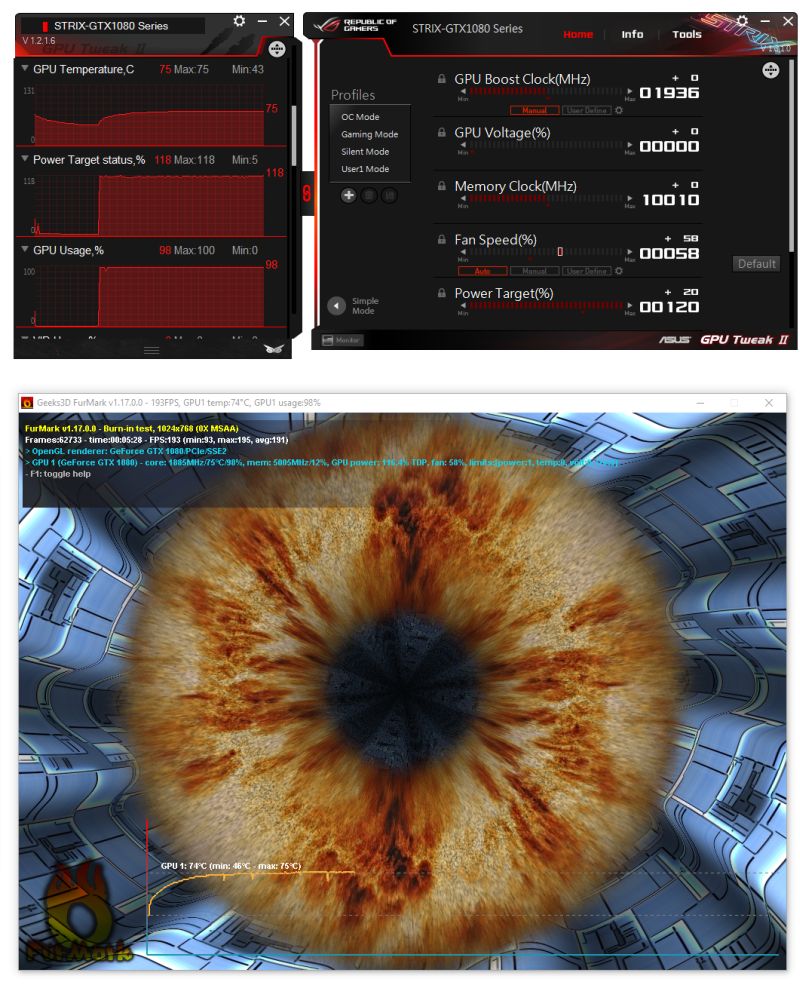
This quick burn-in test has been done with Geeks3D FurMark 1.17 and ASUS GPU Tweak 1.2.16.
Testbed:
– motherboard: ASUS Z170 Gaming Pro
– CPU: Intel Core i5 6600K (default clock speed)
– PSU: Corsair AX860i
– memory: 8GB DDR4 Corsair Vengeance LPX @ 2666MHz
The GPU power target of the Strix GTX 1080 can be set from 46% TDP to 120% TDP. The first thing to do before the burn-in (same thing applies for overclocking) is to set the power target to the max: 120% TDP.
At idle, the total power consumption of the system was 44W and the GPU temperature was 46°C. And the noise? At idle, the Strix GTX 1080 is noiseless because VGA cooler fans are stopped.
I launched FurMark in stress test mode in 1024×768 and after 5 minutes, the GPU temperature reached 75°C while the total power consumption was 304W.
A rough approximation of the Strix GTX 1080 power consumption is (the power consumption of the CPU is around 20W): (304-44-20) * 0.9 = 216W
where 0.9 the the power efficiency factor of the Corsair AX860i PSU.
The GTX 1080 reference board has a TDP of 180W (100% TDP). A GPU power of 116% TDP is equal to 212W. Since the Strix GTX 1080 is overclocked, 216W of maximal power consumption should not be too far from the real value.
At 75°C, the fan noise was really reasonable (41dB measured at around 50cm from the graphics card, open case).
Another important fact: there is no throttling!
Here is the thermal imaging at idle:

and the the thermal imaging under full stress (FurMark):
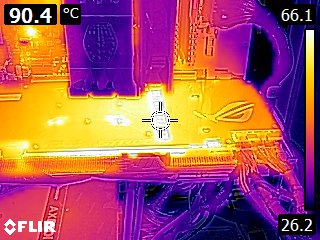
6 – ASUS GPU Tweak and AURA RGB Lighting
Each graphic card maker has its own GPU overclocking and tweaking utility. MSI has Afterburner, EVGA has Precision and ASUS has GPU Tweak.
The latest version of GPU Tweak II can be downloaded from Geeks3D download zone: GPU Tweak II v1.3.1.0.
Thanks to GPU Tweak you can set the power target, the GPU core clock offset, the GPU voltage offsert, the GPU memory clock, GPU temperature target.
GPU Tweak also includes several profiles: OC Mode (max settings), Gaming Mode and Silent Mode.
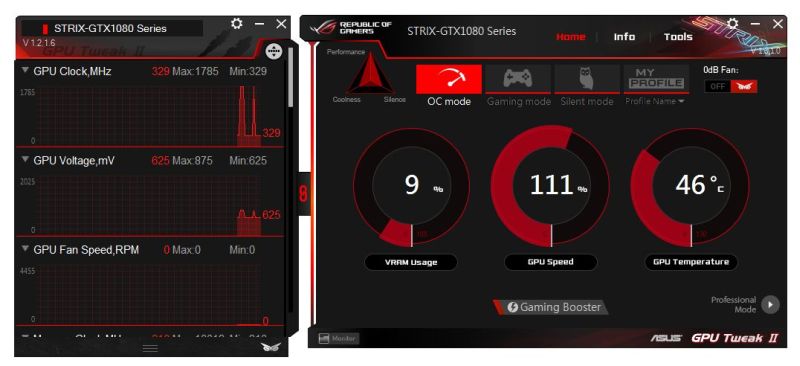
Profile: OC Mode

Profile: Gaming Mode
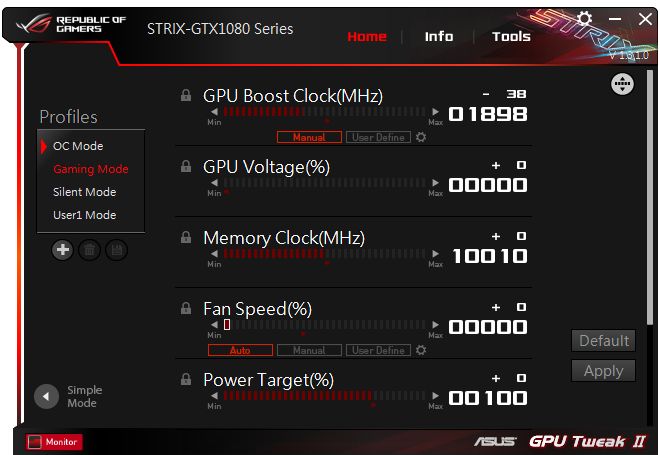
Profile: Silent Mode
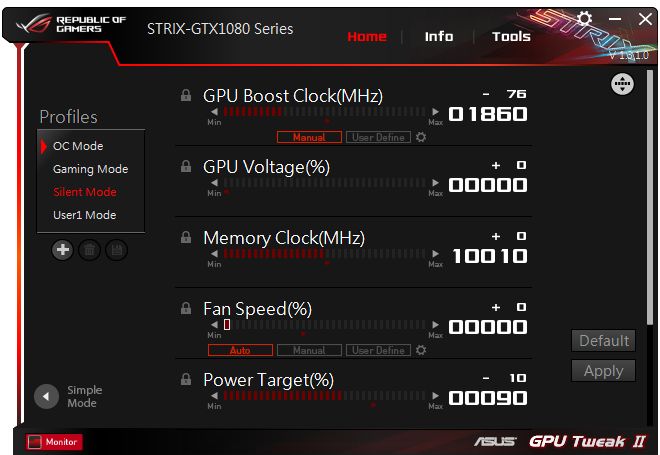
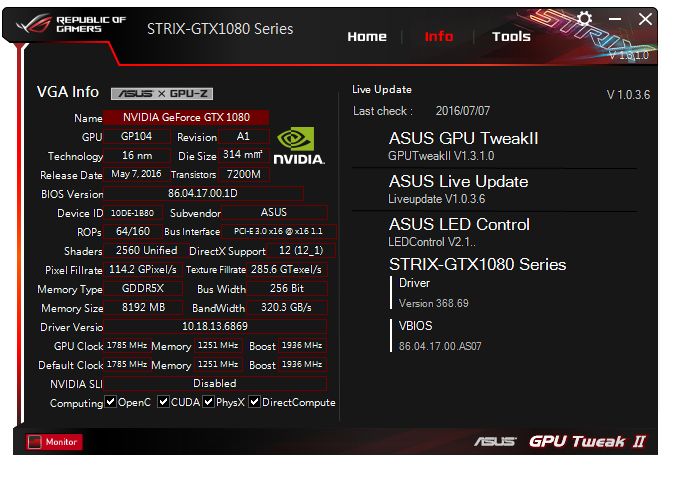
GPU Tweak does not include the support of AURA RGB lighting. To customize the RGB lighting of your ASUS Strix GTX 180, you have to download a separate utility:
ASUS AURA RGB Lighting.
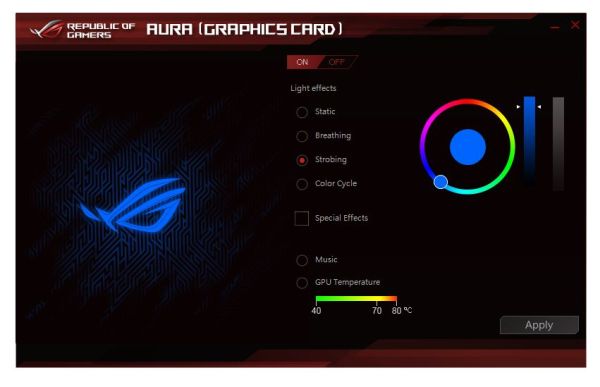
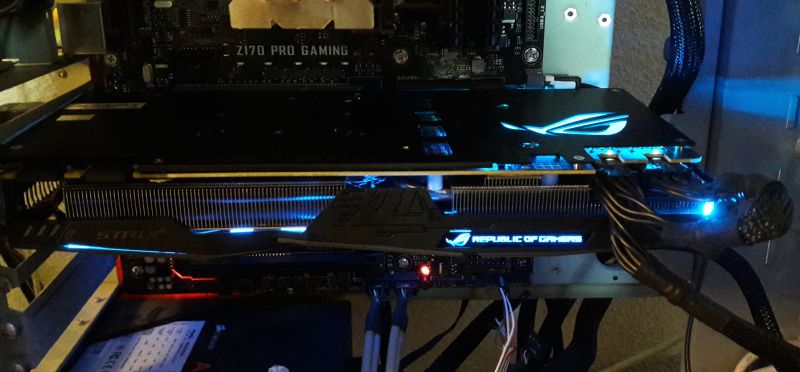
AURA works fine but as a graphics developer, I would have liked to find a simple SDK to program myself the RGB lighting. NVIDIA offers such kind of functions in the NVAPI for the GeForce GTX led logo.
7 – Conclusion
ASUS ROG Strix GTX 1080 O8G GAMING is a really nice product. This card has a nice backplate, quiet VGA cooler (noiseless at idle thanks to the 0dB fans technology, fans being stopped while you are working on desktop applications or browsing the Net, while under full load the VGA cooler noise is very acceptable) and customizable RGB lighting on the VGA cooler shroud as well as on the backplate. There is no GPU core clock throttling, the VGA cooler does a good job by keeping the GPU temperature under 76°C under heavy load and the 8GB of GDDR5X graphics memory offer enough place for gaming at WGHD resolutions (2560×1440) and even at 4K resolutions (3840×2160). What’s more, the Strix GTX 1080 comes with one of the most factory-overcloked GPU on the market (boost clock: 1936MHz).
The board includes two connectors (ASUS FanConnect) that allows to plug two case fans in order to improve case cooling when GPU is under load. The case fans are synchronized with VGA cooler fans.
For VR (virtual reality), the Strix GTX 1080 includes two HDMI 2.0 output connectors.
The bundle is very minimal, I would have liked to see some geeky gadgets/gears in the box…
GPU Tweak does not include the functions to control the RGB lighting and you need to download a separate software for that.
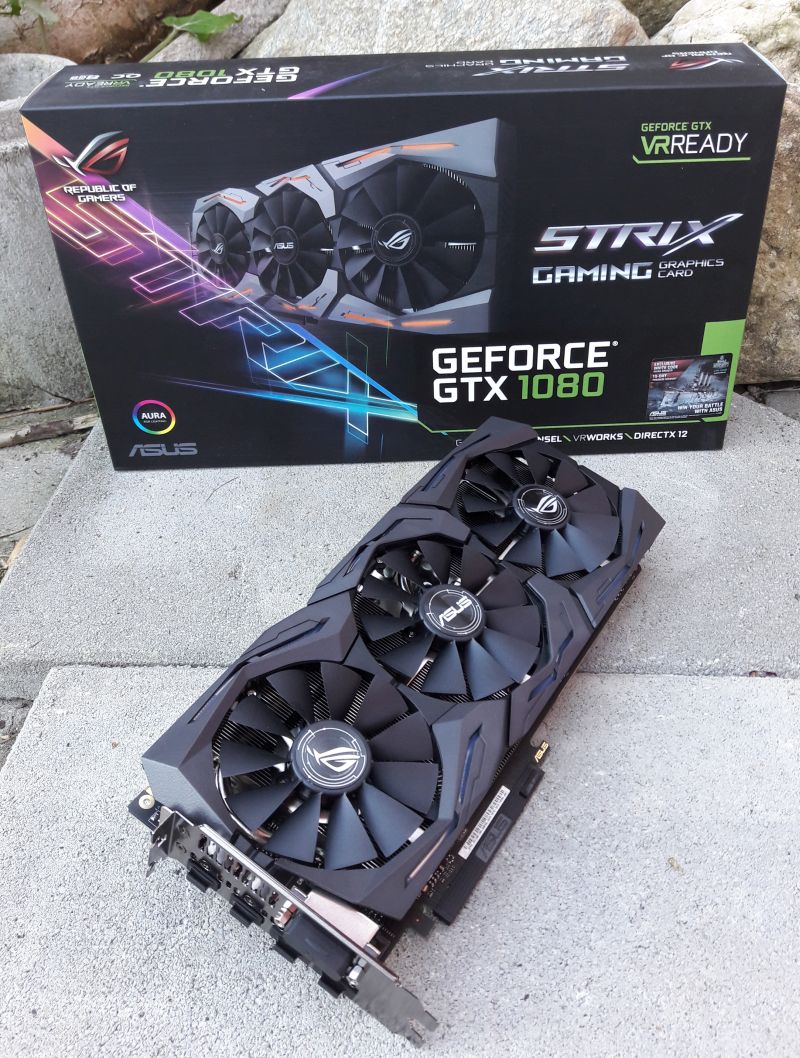
8 – Other reviews
Here is a selection of other reviews of the Strix GTX 1080 8GB:

It only supports 2 Way SLI officially. 3 way and 4 way SLI has been disabled on the driver level by Nvidia. Please correct it. Cheers.
Yes 3-way and 4-way are disabled but they are supported if the user has an Enthusiast Key . I update the article.
Apprently not anymore,
http://www.digitaltrends.com/computing/nvidia-kills-3-and-4-way-sli/
http://www.geforce.com/whats-new/articles/nvidia-titan-x-pascal-available-august-2nd
http://www.geforce.com/hardware/10series/titan-x-pascal
Nvidia officially announced Pascal GP102 TITAN X, 12GB GDDR5X, 480GB/s bandwidth.
is better zotak 1080 apm extreme
Hi. I have a 600W real power PSU. Is safe to use it with this GPU? Thanks.